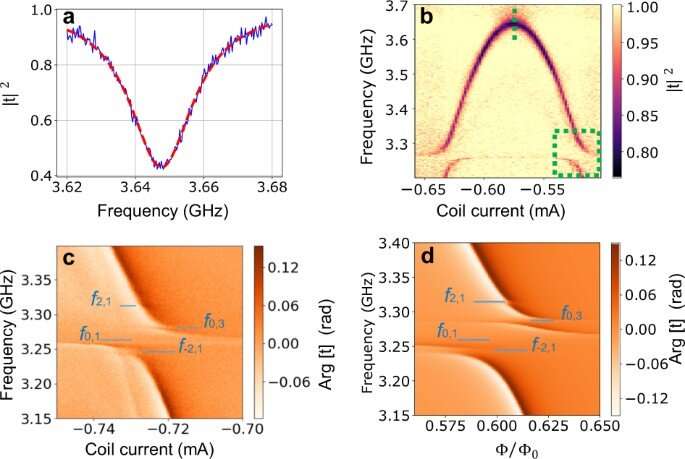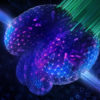Researchers have recently displayed the interaction of superconducting qubits; the basic unit of quantum information, with surface acoustic wave resonators; a surface-wave equivalent of the crystal resonator, in quantum physics. This phenomena opens a new field of research, defined as quantum acoustodynamics to allow the development of new types of quantum devices. The main challenge in this venture is to manufacture acoustic resonators in the gigahertz range. In a new report now published on Nature Communications Physics, Aleksey N. Bolgar and a team of physicists in Artificial Quantum Systems and Physics, in Russia and the U.K., detailed the structure of a significantly simplified hybrid acoustodynamic device by replacing an acoustic resonator with a phononic crystal or acoustic metamaterial.
The crystal contained narrow metallic stripes on a quartz surface and this artificial atom or metal object in turn interacted with a microwave transmission line. In engineering, a transmission line is a connector that transmits energy from one point to another. The scientists used the setup to couple two degrees of freedom of different nature, i.e. acoustic and electromagnetic, with a single quantum object. Using a scattering spectrum of propagating electromagnetic waves on the artificial atom they visualized acoustic modes of the phononic crystal. The geometry of the device allowed them to realize the effects of quantum acoustics on a simple and compact system.
Superconducting quantum systems
Superconducting quantum systems are promising for quantum technologies in quantum informatics and are fundamental to new research directions of quantum optics and artificial atoms. These systems can easily achieve a strong coupling regime even to macroscopic circuit elements. Several research groups had achieved quantum acoustodynamics (QAD) using artificial atoms, where electromagnetic waves can be replaced with acoustic versions and photons by phonons. In this work, Bolgar et al. studied a hybrid circuit where a superconducting qubit was strongly coupled simultaneously to two systems of different nature: acoustic and electromagnetic, with a phononic crystal and a one-dimensional (1-D) transmission line of electromagnetic waves.
A key element in QAD experiments includes a mechanical resonator, which can either be a bulk resonator or a surface acoustic wave (SAW) resonator that plays a similar role as a cavity in quantum electrodynamics (QED). Acoustic elements can be made compact due to their wavelength, which is typically five orders of magnitude shorter than that of electromagnetic waves. Physicists had conducted pioneering experiments with bulk acoustic resonators coupled to superconducting qubits. However, integrating such bulk resonators with electronics is not straightforward. In this experimental setup, Bolgar et al. employed a qubit to play the role of the intermediate system by connecting the acoustic and electromagnetic systems. The researchers used a single long phononic crystal for acoustics of the device to provide the setup a significant technical advantage.
The layout of the device
The team developed the device on a piezoelectric substrate of stable quartz. The device contained a transmon-type qubit, capacitively coupled to a microwave transmission line. In superconducting quantum computing, a transmon is a type of superconducting charge qubit designed for reduced sensitivity to charge noise. The device contained an interdigital transducer (IDT) with equally spaced electrodes in the form of metallic stripes. The IDT capacitance was proportional to the number of electrode pairs. The capacitance electrodes were connected to a superconducting quantum interference device (SQUID) loop; a sensitive detector of magnetic flux and field—used to tune the qubit energies. The periodic structure of the metallic stripes in the setup formed a phononic crystal (or acoustic metamaterial), where each stripe acted as an additional mass on the quartz surface. The group velocity of the waves were much smaller than the sound velocity in the setup, allowing the waves to be effectively confined in the device.
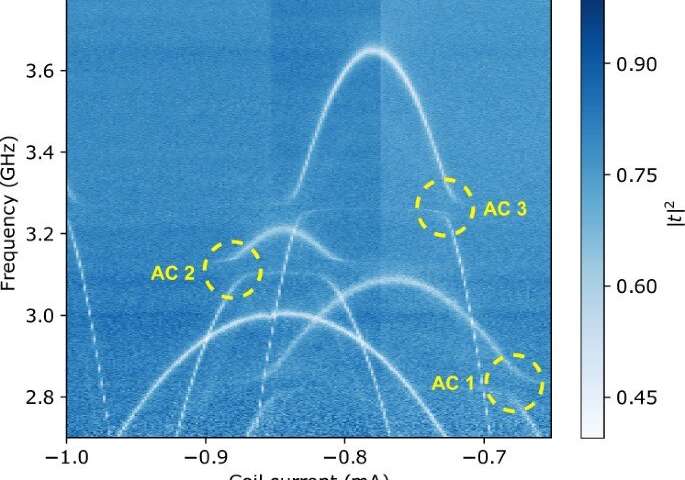
The two-level system coupled to quasinormal modes
The interdigital transducer (IDT) used in the setup, generated surface acoustic waves (SAW) propagating in the longitudinal direction. In contrast to resonators, the waves were not reflected at the boundaries but freely leaked out and as a result, the allowed modes in the system were quasinormal, i.e. damped oscillations. The team then described the Hamiltonian of the hybrid system (a function representing the total energy of a system). In the experimental system, the artificial atom coupled to a phononic crystal interacted with the electromagnetic wave in the transmission line and the team described the dynamics of the scattered waves on the artificial atom, which they measured using transmission spectroscopy. The work contained information on the interaction of the atom with phononic modes.
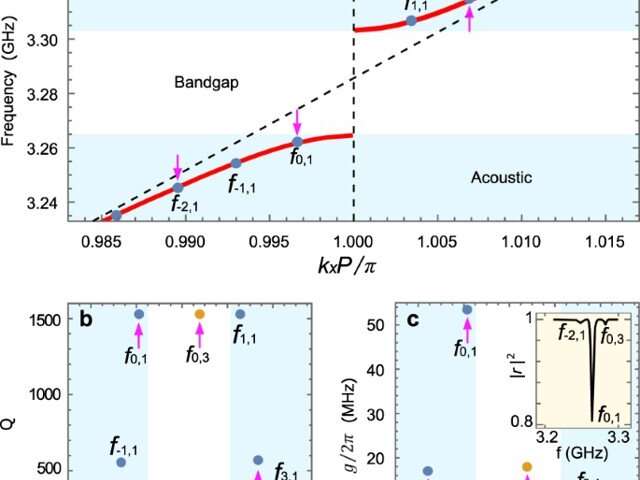
The experimental outcomes
The experimental conditions allowed thermal fluctuations of the setup to be well below the energy of surface acoustic phonons, which are in the gigahertz range of frequencies. The researchers detected the atom-wave interaction, as a change in phase and amplitude of the transmitted signal close to the qubit resonance frequency. They amplified the transmitted signal using cryogenic and room temperature amplifiers and collected the results under a variety of magnetic fields to find the energy splitting of the qubit. The results of spectral line splittings demonstrated the interaction between the qubit and four quasinormal modes (QNMs) of the phononic crystal at four different frequencies. The high quality factors (also termed Q factors) used in the experiment increased with the increasing metallic stripes, where higher Q indicated slower dispersion of the oscillations. This observation was also supported via simulations.
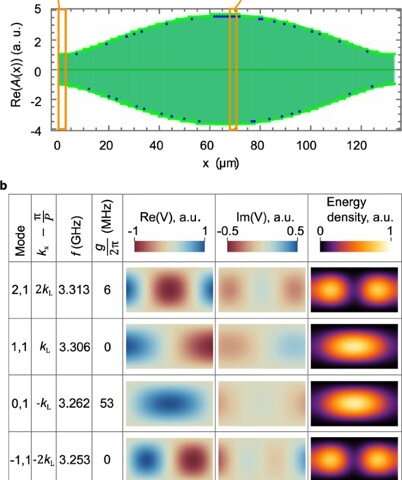
The broader impact on quantum acoustics
In this way, Aleksey N. Bolgar and colleagues experimentally demonstrated the interaction between a qubit and surface acoustic wave (SAW) phononic crystal, formed via a periodic metallic structure on the surface of a quartz material. The team found the modes of the phononic crystal in the circuit by characterizing the scattering of electrodynamic waves on a two-level artificial atom strongly coupled to the crystal. They showed the interaction of the atom with four quasinormal modes of the crystal. The geometry of the engineered device was simple and robust and is more compact than existing bulky setups. The outcomes of this work will contribute to develop devices suited for fundamental quantum acoustics.
Researchers couple artificial atom to acoustic resonator
More information:
1. Bolgar A. N., et al. A phononic crystal coupled to a transmission line via an artificial atom, Nature Communication Physics, doi.org/10.1038/s42005-020-00475-2
2. Chiorescu I. et al. Coherent quantum dynamics of a superconducting flux qubit. Science, 10.1126/science.1081045
3. Kockum A. F. et al. Designing frequency-dependent relaxation rates and Lamb shifts for a giant artificial atom, Physical Review A. doi.org/10.1103/PhysRevA.90.013837
2020 Science X Network
Citation:
A photonic crystal coupled to a transmission line via an artificial atom (2020, November 27)
retrieved 28 November 2020
from https://phys.org/news/2020-11-photonic-crystal-coupled-transmission-line.html
This document is subject to copyright. Apart from any fair dealing for the purpose of private study or research, no
part may be reproduced without the written permission. The content is provided for information purposes only.
